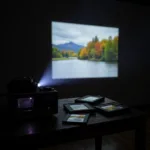Coloring metal can seem daunting, but with the right techniques and a bit of patience, you can transform ordinary metal objects into vibrant works of art. Whether you’re looking to refresh old furniture, create unique jewelry, or add a pop of color to your home decor, understanding How To Color Metal opens up a world of creative possibilities. This guide will explore various methods for coloring metal, from simple DIY techniques to more advanced processes, helping you achieve the perfect finish for your project.
Choosing the right coloring method depends on several factors, including the type of metal, desired finish, and the tools available. Let’s delve into some of the most popular and effective methods for coloring metal.
Painting Metal for a Vibrant Look
Painting is a straightforward and versatile method for coloring metal. It’s ideal for larger surfaces and offers a wide range of color options. Before you begin, ensure the metal surface is clean and free of rust or debris. A primer designed specifically for metal will help the paint adhere better and prevent future corrosion. Once the primer is dry, apply thin, even coats of your chosen paint, allowing each coat to dry completely before applying the next. For a more durable finish, consider using a sealant after the final coat of paint has dried.
Are you looking to give your metal pieces a more luxurious touch? Check out this guide on how to color gold.
Patina: Embracing the Beauty of Age
Patina refers to the natural tarnish that develops on metal over time, creating a unique and often desirable aged look. While patina occurs naturally, you can accelerate the process using various chemical solutions. This technique works particularly well on copper, brass, and bronze. Remember to research the specific patina solution for your metal type and always work in a well-ventilated area. This method offers an organic and sophisticated way to add color and character to your metal pieces.
Powder Coating: A Durable and Versatile Option
Powder coating is a more advanced method that involves applying a dry powder to the metal surface and then curing it with heat. This creates a hard, durable finish that is resistant to chipping, scratching, and fading. Powder coating is an excellent choice for items that will be exposed to the elements or experience heavy use. While it requires specialized equipment, the results are well worth the investment for a professional and long-lasting finish.
Do you know what color is tin? Understanding the base color of different metals can help you choose the perfect coloring method.
Anodizing: Enhancing Aluminum’s Natural Beauty
Anodizing is an electrochemical process specifically for aluminum. It creates a protective oxide layer that can be dyed in a variety of colors. Anodizing not only adds color but also enhances the metal’s corrosion resistance and durability. This technique is commonly used for architectural applications, automotive parts, and consumer electronics.
Wondering if metallic is a color? It’s a common question, and understanding the nuances can help you choose the perfect finish.
Heat Treatment: Unleashing a Spectrum of Hues
Applying heat to certain metals can cause them to change color due to oxidation. This technique, known as heat treatment or flame coloring, can create a variety of iridescent hues, particularly on steel and titanium. While it requires careful control of temperature and time, heat treatment can produce stunning and unique color variations.
Electroplating: Adding a Layer of Precious Metal
Electroplating involves depositing a thin layer of one metal onto another using an electric current. This method can be used to color metal by plating it with a more visually appealing metal like gold, silver, or copper. Electroplating not only changes the color but also enhances the metal’s properties, such as corrosion resistance and conductivity.
Want to know what color is pewter metallic? Explore different metallic shades to find the perfect match for your project.
Conclusion
From simple painting techniques to advanced processes like anodizing and electroplating, there are numerous ways to color metal and transform ordinary objects into captivating pieces. By understanding the different methods and choosing the right one for your project, you can unleash your creativity and achieve stunning results. Remember to always prioritize safety and follow proper procedures when working with chemicals or specialized equipment. Now, armed with this knowledge on how to color metal, go forth and create!
FAQ
-
What is the easiest way to color metal?
Painting is generally the easiest method. -
What is the most durable way to color metal?
Powder coating and anodizing offer the most durable finishes. -
Can I color any type of metal?
Most metals can be colored, but certain methods are specific to certain types of metal. -
Is it necessary to prime metal before painting?
Yes, priming improves paint adhesion and prevents corrosion. -
How can I create a vintage look on metal?
Patina solutions can create an aged look on metals like copper and brass. -
Where can I learn more about flame coloring?
Research online resources and metalworking forums for detailed information on flame coloring techniques. You might also want to learn why do different metals have different characteristic flame test colors. -
What are some safety precautions to consider when coloring metal?
Always work in a well-ventilated area when using chemicals or heat. Wear appropriate safety gear, such as gloves and eye protection.
Have other questions? Check out these other helpful resources on our website:
- Is Metallic a Color?
- What Color is Pewter Metallic?
- What Color is Tin?
- Why Do Different Metals Have Different Characteristic Flame Test Colors?
- How to Color Gold
Need help coloring your metal projects? Contact us! Phone: 0373298888, Email: [email protected] or visit us at 86 Cầu Giấy, Hà Nội. Our customer service team is available 24/7.

